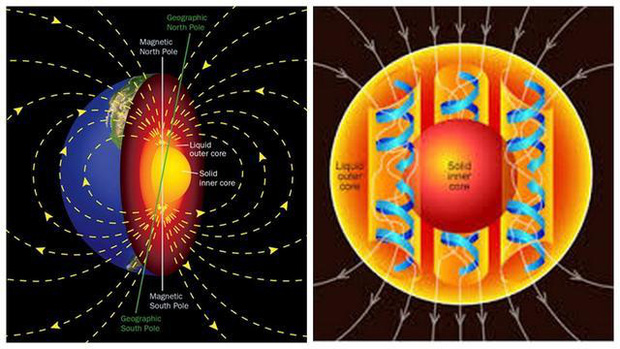In the 1990s, the drift rate of the Earth’s north magnetic pole suddenly increased, from 1990 to 2005, the drift rate reached 60 km per year.
Our Earth is a planet with a very large magnetic field. For billions of years, it has protected terrestrial life from the onslaught of high-energy cosmic rays, shielded our precious atmosphere from the solar wind, and protected life on Earth, like human civilization.
If there is a magnetic field, there is a polarity, in 1831 scientists for the first time confirmed that the Earth’s north magnetic pole is located in the region of Nunavut – the most recent, the most largest and most remote from Canada.
Soon, however, scientists discovered that the Earth’s north magnetic pole appeared unstable and would not be fixed in a single position and had an average rate of movement of around 15 km per year.
However, in the 1990s, the rate of drift from the North Magnetic Pole suddenly increased. From 1990 to 2005, the rate of drift reached 60 km per year, so to speak. In October 2017, the north magnetic pole crossed the international date line and moved from the western hemisphere to the southern hemisphere, then drifted south.
The speed of this polar journey was so fast that the GPD changed direction and forced scientists to create a new global geomorphology to provide information from air navigation to the system. Global Positioning System (GPS) on a smartphone.
So why is the magnetic pole changing so much?
The international date change line, or the international date change line, is an imaginary line used to mark the boundary between the time zone UTC + 14 and UTC-12, approximating the longitude 180 degrees east longitude of the pole North, across the Bering Sea, the Pacific Ocean, to Antarctica, was regulated by the International Conference of Meridian Meetings in Washington in 1884.
A new study from the University of Leeds in the UK suggests it could be caused by major changes inside the Earth. When the Earth’s core radiates heat, it induces convection of molten iron in the liquid outer core and a magnetic field generated by eddy currents coiled liquid iron in the outer part of the core. Therefore, variations in this flow can change the position of the North Pole. However, at the intersection between the core layer and the Earth’s cladding, these two eddy currents have always “tugged” on each other.
This means that if there is an uneven density in the liquid outer core, changes in the magnetic pole can be caused.
Using a seismic scan, scientists determined that the magnetic field is not encapsulated in the core but that fluxes of magnetic fields escape from the earth’s crust. And it is the two magnetic currents under Canada and Siberia that are the places where the magnetic currents in the core escape.
From 1999 to 2019, the bottom line from Canada to Canada continued to stretch and develop east to west and split into two smaller interconnected magnetic field lines, which possibly be formed due to the change of the earth’s core during the period 1970-1999.
Prof Livermore said the team predicted the magnetic north pole would continue to move towards Siberia, but it was difficult to predict the future and they couldn’t confirm it.
This division of the magnetic flux in Canada decreases causes the weakening of the magnetic field of the current, and the stronger magnetic field current tends to be closer to Siberia, which also causes the lateral magnetic flux. Under Siberia becomes stronger and pulls its north pole towards it.
However, scientists believe that these two large magnetic field currents are inherently in equilibrium, but with only a few small changes the position of the north magnetic pole can be altered and very difficult to have. It is possible to predict how the North Pole will pass next.
For 7,000 years, the magnetic north pole has been moving around the North Pole in a chaotic fashion, without following any rules. It moved to Siberia in 1300 BC and has drifted downstream to Canada for the past 400 years.
This displacement of the magnetic pole shows that two or sometimes three magnetic currents deep in the ground affect the position of the pole in time. These currents have caused the north magnetic pole to shift in northern Canada for the past 400 years. But over the past 7,000 years, the North Magnetic Pole only appears to have moved around the geographic North Pole. According to the computer model, the magnetic north pole also moved to Siberia in 1300 BC.
But you can be assured that this change in the position of the magnetic pole will have no effect on life on Earth. Even if it goes further, there is no need to panic because it has happened so many times before, only the interior of the Earth will always change.





